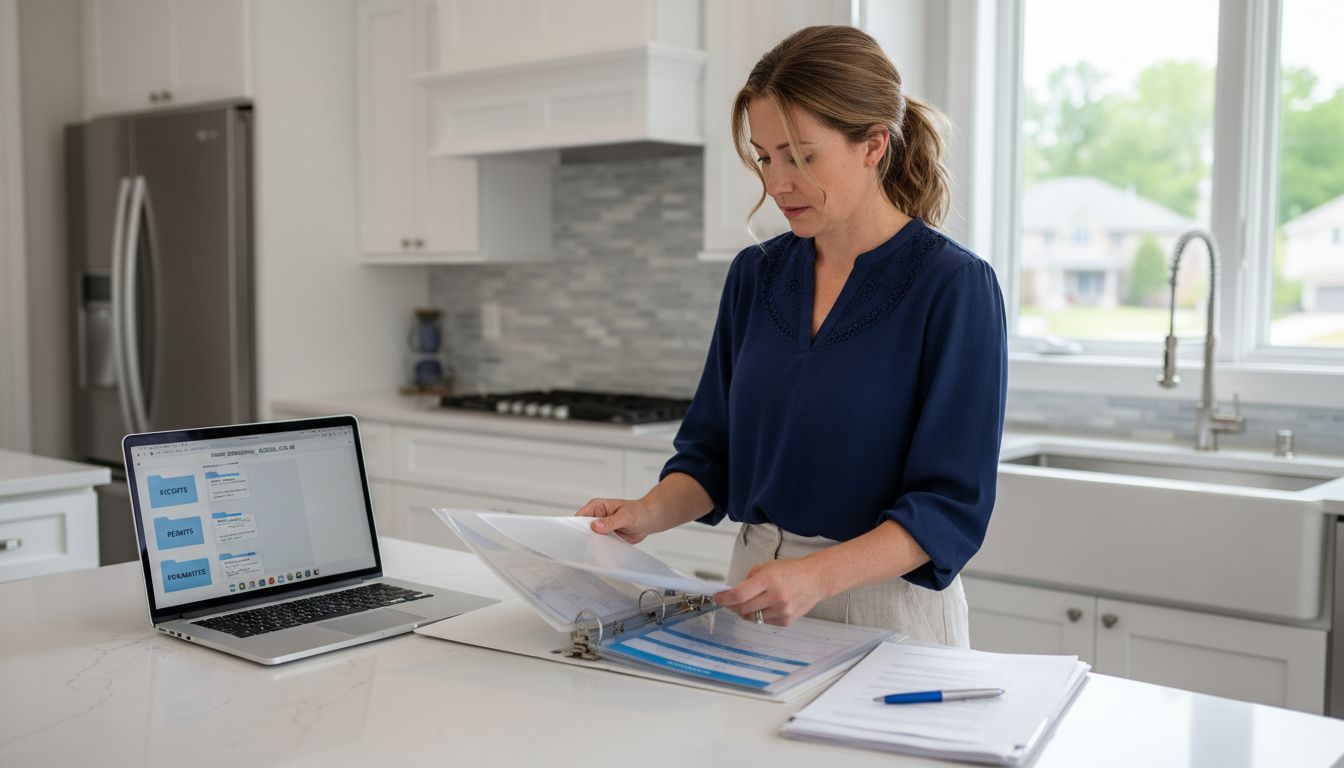Preparing for a Home Appraisal: Maximize Your Property Value

Over 80 percent of homeowners miss out on higher appraised values simply because they overlook a few vital steps in preparing their property. The way you present your home before an appraisal can make a substantial difference in its final valuation. With strategic preparation and organized records, you can help ensure your home gets the recognition—and value—it truly deserves.
Table of Contents
- Step 1: Assess And Document Recent Home Improvements
- Step 2: Enhance Your Home’s Curb Appeal
- Step 3: Clean And Declutter All Interior Spaces
- Step 4: Address Minor Repairs And Maintenance Issues
- Step 5: Compile Relevant Documentation For The Appraiser
- Step 6: Review And Confirm Home’s Market-Ready Condition
Quick Summary
| Key Point | Explanation |
|---|---|
| 1. Document All Home Improvements | Keep a detailed record of upgrades and renovations, including costs, materials, and contractor information, to highlight your home’s added value during appraisal. |
| 2. Focus on Curb Appeal | Make exterior updates like fresh landscaping, paint touch-ups, and clean walkways to create a strong first impression and positively influence appraised value. |
| 3. Declutter and Clean Interiors | A spotless, organized interior feels more spacious and well-maintained, helping appraisers see your home’s true condition and worth. |
| 4. Address Minor Repairs | Fix small issues such as leaky faucets, chipped paint, or loose handles before the appraisal to prevent them from lowering your property’s valuation. |
| 5. Prepare Comprehensive Documentation | Gather receipts, warranties, and permits for all major improvements to verify quality and demonstrate that upgrades were professionally completed. |
Table: Essential steps homeowners in Oakland County, Michigan can take to prepare for a successful home appraisal and maximize their property’s assessed value.
Step 1: Assess and document recent home improvements
Preparing comprehensive documentation for your home improvements is critical when maximizing your property’s appraisal value. According to the Appraisal Institute, providing detailed records of home enhancements can significantly impact how appraisers assess your property’s worth.
Start by creating a systematic documentation portfolio that tracks every improvement made to your home. Consumer Reports recommends maintaining a comprehensive list that includes specific details like:
- Date of improvement
- Total cost of project
- Materials used
- Contractor information (if applicable)
- Permits obtained
- Before and after photographs
Organize your documentation in a clear binder or digital folder that you can easily present to the appraiser. Include receipts, contract agreements, and any warranty information for major upgrades like kitchen remodels, bathroom renovations, roof replacements, or energy efficient installations. By presenting a thorough record of your home’s improvements, you provide concrete evidence of the value you’ve added to the property.

Remember that not all improvements carry equal weight. Focus on documenting upgrades that typically increase home value such as kitchen and bathroom renovations, added square footage, new windows, updated HVAC systems, or significant landscaping work. The more detailed and professional your documentation, the more likely an appraiser will recognize and validate the added value to your home.
Step 2: Enhance your home’s curb appeal
Curb appeal plays a crucial role in maximizing your home’s appraisal value. University of Texas at Arlington research reveals that homes with high curb appeal can sell for up to 7% more than properties with less attractive exteriors.
Start by focusing on key visual elements that create a strong first impression. Consumer Reports recommends several strategic upgrades that can transform your home’s exterior:
- Power wash your home’s siding and walkways
- Apply a fresh coat of paint to your front door
- Trim and shape existing landscaping
- Plant colorful flowers and well maintained shrubs
- Repair or replace outdated exterior lighting
- Ensure your lawn is green and neatly mowed
Pay special attention to your front entrance as it serves as the focal point for potential appraisers. A well maintained entrance suggests overall property care and can significantly influence the appraiser’s perception. Consider updating hardware like door handles, adding potted plants, and ensuring the area is clean and welcoming.
Remember that curb appeal is about creating a cohesive and polished look. Small investments in exterior maintenance can yield substantial returns during your home appraisal. Think of your home’s exterior as a preview of the quality and care found inside the property.
Step 3: Clean and declutter all interior spaces
Maximizing your home’s appraisal value requires meticulous interior preparation. Appraisal Institute recommends thoroughly cleaning and decluttering interior spaces to positively influence the appraiser’s perception of your property’s overall condition.
Start by systematically addressing each room with a strategic approach. Consumer Reports suggests focusing on making spaces appear larger and more inviting. Begin with these critical decluttering steps:
- Remove personal items and excess furniture
- Clear countertops and surfaces
- Organize closets and storage areas
- Pack away seasonal clothing and decorative items
- Create open walkways in each room
- Store personal photographs and memorabilia
Pay special attention to high traffic areas like kitchens and living rooms. A deep clean means more than just surface tidying. Scrub floors, wash windows, clean baseboards, and ensure every surface sparkles. Professional cleaning can make your home feel more spacious and well maintained, which directly impacts an appraiser’s assessment.
Remember that appraisers are trained to look beyond surface appearances. A meticulously cleaned and organized home suggests you have carefully maintained the property. Your goal is to present a space that looks cared for and moves smoothly from room to room without visual interruptions or clutter distractions.
Step 4: Address minor repairs and maintenance issues
Preparing for a home appraisal requires a proactive approach to addressing small maintenance concerns. Appraisal Institute advises homeowners to tackle minor repairs before the appraiser arrives to prevent potential deductions in the property’s assessed value.
Start by conducting a comprehensive walkthrough of your home, identifying and documenting all necessary repairs. Consumer Reports emphasizes the importance of addressing maintenance issues that can negatively impact your home’s appraisal. Focus on these key areas:
- Repair leaky faucets and running toilets
- Fix any damaged drywall or paint chips
- Replace cracked electrical outlet covers
- Tighten loose door handles and cabinet knobs
- Repair or replace damaged window screens
- Address any flooring issues like loose tiles or squeaky boards
Prioritize repairs that are visible and impact the home’s overall functionality. While you don’t need to invest in major renovations, ensuring that everything works correctly demonstrates proper home maintenance. Small investments in repairs can prevent appraisers from noting significant maintenance concerns that could potentially lower your home’s value.
Remember that attention to detail matters. A home that appears well maintained suggests to the appraiser that you have been a conscientious homeowner who has taken care of the property over time. Take the time to complete these minor repairs thoroughly and systematically to present your home in the best possible light.
Step 5: Compile relevant documentation for the appraiser
Appraisal Institute recommends providing comprehensive documentation to substantiate your home’s value. Gathering the right paperwork can significantly impact the accuracy of your property appraisal and potentially increase its assessed worth.
Consumer Reports advises homeowners to compile a complete portfolio of property documentation. Organize your materials into the following critical categories:
- Recent home improvement receipts
- Permit documents for major renovations
- Detailed list of property upgrades
- Original home purchase documents
- Property tax records
- Warranty information for major systems and appliances
- Neighborhood comparable sales information
Create a professional presentation folder that makes it easy for the appraiser to review your documentation. Include clear copies of receipts with dates and costs highlighted. Add before and after photographs of significant improvements to provide visual evidence of your home’s enhanced value. Your goal is to create a comprehensive narrative that demonstrates the care and investment you have made in maintaining and improving your property.

Preparing this documentation shows the appraiser that you are a thorough and responsible homeowner. By presenting a well organized collection of records, you help the appraiser understand the true value of your home beyond its basic structural components. Think of this documentation as your home’s resume professional credibility.
Step 6: Review and confirm home’s market-ready condition
Appraisal Institute recommends conducting a comprehensive walkthrough to ensure your home presents its best possible condition. This final inspection is crucial for identifying any last minute details that could impact your property’s appraisal value.
Consumer Reports advises homeowners to assess their property from a potential buyer’s perspective. Your final review should focus on these key areas:
- Check all paint and wall surfaces for imperfections
- Verify all light fixtures and electrical outlets function properly
- Inspect flooring for scratches or wear
- Ensure all doors and windows open and close smoothly
- Look for any signs of water damage or moisture
- Confirm all major home systems are operational
- Validate that exterior areas are clean and well maintained
Take time to view your home objectively. Walk through each room as if you were seeing it for the first time. Pay attention to details a professional appraiser would notice the overall condition, functionality, and potential maintenance concerns. A meticulous final review demonstrates your commitment to presenting a well cared for property.
Remember that preparation is key. Your goal is to present a home that looks loved and maintained. By taking these final steps, you maximize your chances of receiving an accurate and potentially higher appraisal value. Trust in your thorough preparation and approach the appraisal with confidence.
Maximize Your Home Appraisal Value With Expert Local Guidance
Preparing your home for an appraisal can feel overwhelming when you face multiple tasks like documenting improvements, enhancing curb appeal, and handling minor repairs. These important steps determine if your property’s value reaches its true potential. The challenge is showing the appraiser every detail that elevates your home’s worth while confidently navigating the Oakland County real estate market.
That is where Tom Gilliam at Homes2MoveYou.com makes the difference. With over 20 years of experience serving Farmington Hills and surrounding communities, Tom understands how to strategically position your home for a higher appraisal by emphasizing key factors like well-documented upgrades and pristine presentation. His expert pricing strategies and negotiation skills help you get the most from your investment while minimizing stress throughout the selling process.

Get the professional support you need to transform preparation challenges into a competitive advantage. Visit Homes2MoveYou.com to connect with Tom Gilliam and discover how his deep local knowledge and proven solutions deliver results. Start today to increase your home’s value potential before your next appraisal appointment.
Frequently Asked Questions
How can I effectively assess and document my home’s recent improvements for the appraisal?
To maximize your property value, create a detailed record of all improvements made to your home. Document dates, costs, materials, permits, and include before and after photos, presenting this information in an organized binder or digital folder for the appraiser.
What curb appeal improvements should I focus on before a home appraisal?
Enhance your home’s curb appeal by cleaning driveways, painting the front door, and maintaining your landscaping. Simple actions like adding colorful flowers and ensuring a neat lawn can significantly impact the appraiser’s first impression.
What specific areas should I declutter to prepare for my home appraisal?
Focus on decluttering major living spaces, especially high-traffic areas like the kitchen and living room. Clear surfaces, organize closets, and remove personal items to create an inviting environment that highlights your home’s best features.
Which minor repairs should I prioritize before an appraisal?
Address visible maintenance issues such as leaky faucets, chipped paint, and loose door handles to prevent deductions in your home’s value. Conduct a thorough walkthrough and tackle at least five minor repairs to demonstrate overall home upkeep.
What type of documentation should I compile for the appraiser?
Gather relevant papers like receipts for recent improvements, permit documents, and property tax records to support your home’s appraisal value. Organize these documents in a professional folder to create a comprehensive portfolio that clearly presents your property’s value.
How can I ensure my home is in market-ready condition for the appraisal?
Conduct a final walkthrough before the appraisal to spot any last-minute issues. Focus on checking that all electrical fixtures work, surfaces are clean, and no signs of damage are present, presenting a home that looks well cared for.
Recommended




